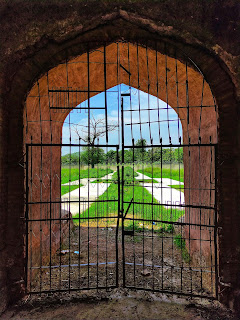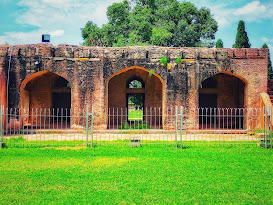Wah Gardens is one of just two known Mughal gardens in Pakistan that are located outside of Lahore have survived the ravages of time, the other being the Bagh-e-Safa in Kallar Kahar. Thankfully, unlike some other monuments, the garden is well-maintained, and you can immediately discern its former splendor, as it still retains its beauty and elegance. The garden is located at 33°48'05.0"N 72°42'01.5"E, near the historic settlement of Wah in Punjab's Taxila Tehsil in district Rawalpindi on the Grand Trunk (G.T. Road) around 40 kilometres from Islamabad and 12 kilometres from Taxila, is one such example of historically valuable Mughal place. It is a large garden that spans about 15 acres.
The Mughals were garden enthusiasts, and throughout their reign, they created hundreds of gardens across the subcontinent. Their tombs and sarais (inns) featured extensive gardens in addition to lawns and parks. The most well-known examples in Pakistan are The Shalimar Garden, The Tomb of Jehangir, also known as Akbari Sarai, and The Tomb of Noor Jehan. These are all lovely examples of the confluence of Mughal architecture and gardens.
Despite the fact that all prominent Mughal rulers and local conquerors visited the area at some point, Wah is most closely connected with three kings: Akbar, Jehangir, and Shah Jehan. This was a famous rest station on the route from Lahore to Kabul. According to legend, Akbar (or, in other versions, Jehangir) was captivated by the natural beauty of the place and screamed "Wah!" (Wow), and Jehangir renamed it "Wah" from its previous name, "Jalal Sar."
Raja Man Singh, a Rajput Monarch, Akbar's closest and famed military commander, and Emperor Jehangir's father-in-law and of Akbar's "Nine Gems," built this magnificent garden. He stayed in this area from 1581 to 1586 to settle disputes along the North Western frontier. During his visit, he created a garden at this area. There was a creek and a natural pond here, and he built a small garden around it. In awe of the natural beauty, he built a baradari (twelve-door building) in the midst of a vast man-made pond that diverted water from adjacent rivers.
A few years later, on his route to Kabul in 1607, Emperor Jehangir stopped for three days and fished in the pond. He loved the surroundings and gave it the name 'Wah,' which is an approving shout. Yet it was Shah Jahan who laid out a large park and built many gorgeous structures and pavilions to beautify it.
He visited this location in 1639 and delegated this job to his main engineer, architect Ahmed Meymar Lahori. Ustad Meymaar branched out the centre pond's waterways to create fountains, canals, and toilets with both hot and cold water. At its peak, the Gardens extended over 20 acres, with crisscrossing canals and waterfalls, as well as numerous structures on various levels all around that centre pond. In addition, when other royals went between Kashmir and Kabul, artists created lavishly adorned guest rooms and hammams (royal baths). Shah Jehan, in particular, was said to have spent the most time at Wah, visiting there five times throughout his reign. The garden was built under his direction and took around two years to complete. The garden was designed to pay respect to the particular Mughal architectural style. Cold and hot water were available in hamams (bathrooms). To enhance the area, many different types of plants and flowers were planted.
Shah Jahan loved gardens and visited here several times between 1646 and 1654. Abdul Hameed Lahori and Muhammad Saleh Kamboh, his courtiers, compared its splendour to that of paradise. In 1676, Emperor Aurangzeb was the only Mughal emperor to visit Wah for an extended period of time, staying for two years and funding monument renovations.
It was an important stop for Mughal princes and officials, and it was known as a "farood gah," or royal resting spot. As a result, it doubled as a sarai (inn) and a pleasure garden. Although residents in Wah continue to visit this garden for amusement, it has been in a condition of utter ruin since the Mughals, with much of the original design work destroyed. During the Mughals' demise, the garden fell on hard times and suffered greatly throughout the Afghan and Sikh periods. Most of the devastation occurred under the Durrani Dynasty (1747-1826) and the Sikh reign (1826-1849). Wah Gardens remain neglected throughout the British Raj. The British occupation of Punjab in 1849 gave away Wah Gardens (along with most of the Wah area) to Nawab Muhammad Hayat Khan. The Nawab's employees were housed in the old baradari and several Mughal structures, while the huge acreage was transformed into agriculture for the cultivation of wheat and sugarcane.
Wah Gardens is historically rich in history, legends, and hints about Mughal aesthetics and lifestyles. Despite its closeness to Taxila and Islamabad, no regulatory agency has recognised it as a major heritage or tourism site. Although we may not be able to entirely reproduce Wah Gardens as the Mughals saw it, good conservation work and diligent upkeep can help restore some of the pleasure gardens' former magnificence as well as sugarcane.
My recent to Wah Gardens was enjoyable. It is a fantastic recreational area that is equally fun for young and old alike. This magnificent garden is only around 40 kilometres, or approximately an hour's drive, from Islamabad. Therefore, I recommend you to take some time out of your day and organise a picnic at the Wah Garden on a nice day to enjoy the beauty of the garden and its equally lovely backdrop.


























1 Comments
Articulately wrriten.
ReplyDeleteThanks you so much for your comment. We will reply to this shortly.